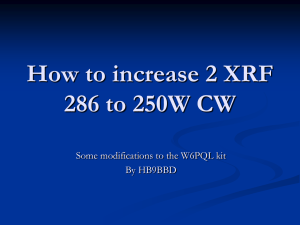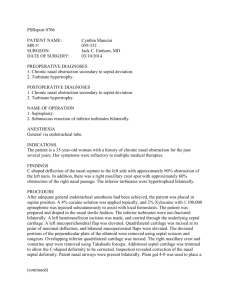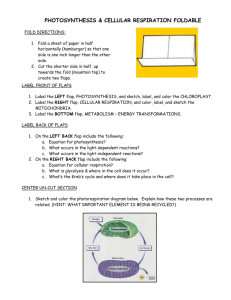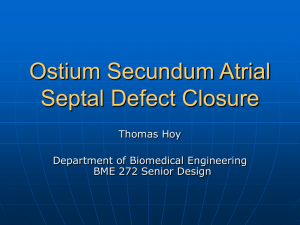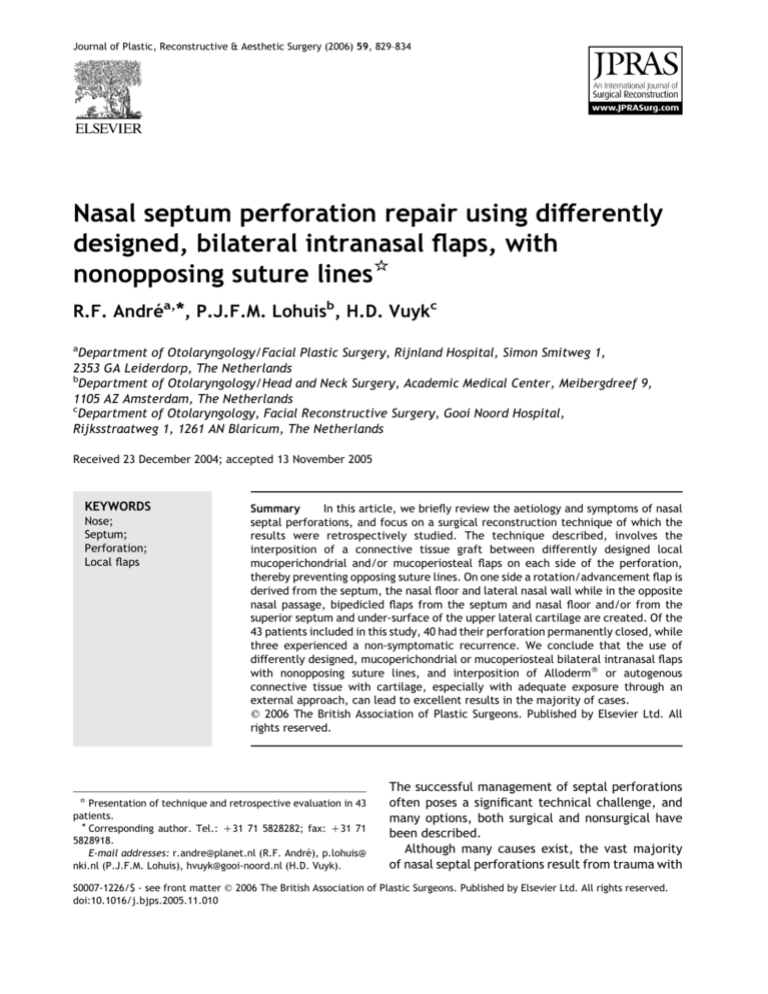
Journal of Plastic, Reconstructive & Aesthetic Surgery (2006) 59, 829–834
Nasal septum perforation repair using differently
designed, bilateral intranasal flaps, with
nonopposing suture lines*
R.F. Andréa,*, P.J.F.M. Lohuisb, H.D. Vuykc
a
Department of Otolaryngology/Facial Plastic Surgery, Rijnland Hospital, Simon Smitweg 1,
2353 GA Leiderdorp, The Netherlands
b
Department of Otolaryngology/Head and Neck Surgery, Academic Medical Center, Meibergdreef 9,
1105 AZ Amsterdam, The Netherlands
c
Department of Otolaryngology, Facial Reconstructive Surgery, Gooi Noord Hospital,
Rijksstraatweg 1, 1261 AN Blaricum, The Netherlands
Received 23 December 2004; accepted 13 November 2005
KEYWORDS
Nose;
Septum;
Perforation;
Local flaps
*
Summary
In this article, we briefly review the aetiology and symptoms of nasal
septal perforations, and focus on a surgical reconstruction technique of which the
results were retrospectively studied. The technique described, involves the
interposition of a connective tissue graft between differently designed local
mucoperichondrial and/or mucoperiosteal flaps on each side of the perforation,
thereby preventing opposing suture lines. On one side a rotation/advancement flap is
derived from the septum, the nasal floor and lateral nasal wall while in the opposite
nasal passage, bipedicled flaps from the septum and nasal floor and/or from the
superior septum and under-surface of the upper lateral cartilage are created. Of the
43 patients included in this study, 40 had their perforation permanently closed, while
three experienced a non-symptomatic recurrence. We conclude that the use of
differently designed, mucoperichondrial or mucoperiosteal bilateral intranasal flaps
with nonopposing suture lines, and interposition of Allodermw or autogenous
connective tissue with cartilage, especially with adequate exposure through an
external approach, can lead to excellent results in the majority of cases.
q 2006 The British Association of Plastic Surgeons. Published by Elsevier Ltd. All
rights reserved.
Presentation of technique and retrospective evaluation in 43
patients.
* Corresponding author. Tel.: C31 71 5828282; fax: C31 71
5828918.
E-mail addresses: r.andre@planet.nl (R.F. André), p.lohuis@
nki.nl (P.J.F.M. Lohuis), hvuyk@gooi-noord.nl (H.D. Vuyk).
The successful management of septal perforations
often poses a significant technical challenge, and
many options, both surgical and nonsurgical have
been described.
Although many causes exist, the vast majority
of nasal septal perforations result from trauma with
S0007-1226/$ - see front matter q 2006 The British Association of Plastic Surgeons. Published by Elsevier Ltd. All rights reserved.
doi:10.1016/j.bjps.2005.11.010
830
or without secondary infections. Surgical trauma
during septoplasty is still one of the main
offenders,1–4 although less frequently so since the
technique of submucous resection has largely been
abandoned.5 Other traumatic causes include tight
nasal packing, bilateral cauterisation of nosebleeds, repeated nose picking, or inadequately treated
septal haematoma with subsequent septal abscess.
Various diseases, such as Wegener’s granulomatosis,
autoimmune disorders with vasculitis, neoplasms and
rare infections such as tuberculosis and syphilis, may
lie at the origin of a perforation, sometimes as the
sole manifestation of such a disease. Cocaine may
cause septal perforations not only due to its
vasoconstrictive properties but also because of
irritant additives that are often added to non-medical
grade cocaine.6–8
An estimated two-thirds of perforations are either
asymptomatic or cause minimal symptoms. In
general, the larger and the more anteriorly located
a perforation is, the more likely it is to cause
symptoms,2 such as crusting, nasal obstruction,
rhinorrhoea, epistaxis, uncomfortable sensations
while inhaling cold air and sometimes headache.
Smaller perforations may lead to noisy breathing or
whistling. Both nasal obstruction and crusting can be
caused by excessive turbulence in the inspiratory
airflow. Large perforations may seriously compromise structural support of the anterior and middle
third of the nose, leading to saddling which may
further impede nasal airflow.
Treatment is only necessary for symptomatic
perforations and may be conservative, prosthetic or
surgical. Repeated application of moistening, and
when indicated, antibacterial ointments and nasal
douching with saline, is sometimes all that is
needed to reduce or cure symptoms of crusting
and bleeding. Another option is to close the
perforation by inserting a prosthetic device (usually
a preformed silicone or silastic button).9 A prosthesis generally needs to be cleaned and/or
replaced regularly, is not well tolerated by all
patients and sometimes may actually cause nasal
obstruction, either because it induces increased
mucus secretion and mucosal swelling or simply
because of the thickness of the prosthesis.
The most important predictor of successful
surgical perforation closure is the size of the
perforation. The vertical height of a perforation is
more critical than the anteroposterior dimensions,
as the approximation of the mucoperichondrial
edges from the floor of the nose to the dorsum
causes the greatest tension.6 A nasal septal
perforation may present with a cartilaginous
perforation that is considerably larger than the
apparent mucosal perforation. This may severely
R.F. André et al.
complicate dissection and mobilisation of mucosal
flaps.
The literature describes a multitude of techniques for surgically closing a nasal septal perforation,10–27 which may be a reflection of the
complexity of any such surgical undertaking. To
start with there is the problem of a relatively
limited surgical exposure, especially through an
endonasal approach. This complicates the already
difficult task of separating and individually repairing each part of the three-layer architecture of the
septum, necessary for the best chance of a lasting
closure.1,10 Matters are further complicated by a
relative paucity of suitable donor material, at least
regarding the respective mucoperichondrial layers.
The mainstay of treatment today involves the use of
local mucosal flaps with interposition of a connective tissue graft, frequently through an external
rhinoplasty approach as this greatly enhances
surgical exposure. An excellent review of the
various techniques used for surgical septal perforation closure was published in this journal by
Cogswell and Goodacre in this journal in 2000.11
Patients and methods
Between July 1991 and June 2002, 46 patients with
a septum perforation were operated upon by the
same surgeon (HDV) using bilateral mucoperichondrial rotation/advancement flaps. Of these
patients, three had a follow-up of less than 3
months and were excluded from the study. The
average follow-up was 29 months (range 3–138
months). There were 10 women and 33 men and the
average age was 36.6 years (range 16–68 years). In
14 cases the perforation was caused by previous
septal surgery, in 12 cases it was due to nose
picking, in three cases the cause was cocaine abuse,
in two cases there had been a nasal trauma and in 12
cases no underlying cause was found. In six
patients, the diameter of the perforation was
smaller than 5 mm, in nine patients it was between
5 and 10 mm, in 26 patients it was between 10 and
20 mm and in two patients the diameter was larger
than 20 mm. In 11 patients, a single layer of
Allodermw was used as interposition graft while in
the other 32 patients ear cartilage was sandwiched
between two layers of temporalis fascia. An
endonasal approach was used in seven patients, in
the other 36 an external approach was used, the
details of which will now be described insofar as
they pertain to this specific procedure.
The first step of the operation is to incise the
intranasal flap margins using a rigid 0-degree
Nasal septum perforation repair using bilateral intranasal flaps
nasendoscope and a specially bent and hooked
(Beaver) knife. Subsequently, a mid-columellar
broken line skin incision is connected with bilateral
marginal incisions as for a standard external
approach. The nasal skin is carefully elevated
from the underlying nasal skeleton in the supraperichondrial plane. The caudal edge of the cartilaginous septum is exposed after complete division of
the intermedial crural and interdomal ligaments.
The upper lateral cartilages are dissected from the
dorsal edge of the septum on both sides. Subsequently, bilateral mucoperichondrial flaps are
elevated from the septum and extended around the
perforation. The goal of mucosal flap mobilisation is
to close the defect completely on both sides, while
avoiding opposing suture lines and maintaining
adequate blood supply. Different designs of mucoperichondrial flaps are used on each side of the
perforation to prevent opposing suture lines. On
one side a rotation/advancement flap is derived
from the septum, the nasal floor and lateral nasal
wall Fig. 1. Mucoperichondrium dissected from the
septum is extended in continuity with the mucoperiosteum of the floor of the nose and up the lateral
wall until the attachment of the inferior turbinate.
In larger perforations (bigger than 2.5 cm), the
rotation flap is designed to include lateral and/or
medial mucosa from the inferior turbinate. These
rotation flaps are mostly based anteriorly on the
branches of the superior labial artery.24 This is
preferable to posteriorly based mucoperiosteal
flaps that are often too short to reach an anterior
septal perforation.8 In the opposite nasal passage,
bipedicled flaps from the septum and nasal floor are
developed6,22 and usually a superior mucoperichondrial bipedicled septal flap is also created Fig. 2.
Sometimes mucoperichondrium from the undersurface of the upper lateral cartilage is included or
alternatively a cut may be made in the mucoperichondrium at the junction of the septum and upper
lateral cartilage, creating a bipedicled flap to
advance inferiorly.23,28 If a concomitant reduction
rhinoplasty is indicated, lowering of the nasal
dorsum will help to create a relative excess of
mucoperichondrium to be used for perforation
closure.29 Occasionally, a perforation cannot be
closed completely on one or both sides and the
connective tissue interpositional graft can serve as
a template for migration of the overlying healing
flaps.23,30 The mucosal flaps are approximated,
using nontraumatic forceps, and sutured without
tension with multiple fast absorbable 5/0 Vicrylw
sutures. Autogenous fascia and/or periosteum are
obtained through a high postauricular temporal skin
incision. Thickness depends on whether superficial
temporalis fascia, loose areolar tissue or deep
831
Figure 1 (a) and (b) An inferoanteriorly based rotation/advancement mucoperichondrial flap.
temporalis fascia is taken.31 The connective tissue
grafts are placed under the mucoperichondrial flaps
on both sides of the septum and should ideally
overlap the defect on all sides. Subsequently, the
cartilaginous and bony defect is reconstructed with
auricular autogenous cartilage, which should fit
precisely. Alternatively one layer of acellular
832
R.F. André et al.
dressing is applied for 24 h. The nose is taped and
a cast applied for 1 week. The splints are usually
left in place for 2–3 weeks. The nose is kept moist
with nasal douches, using saline solution and
ointment. Broad-spectrum antibiotics are administered 1 h before the operation and continued for
7 days.
Results
At a minimum of 3 months all patients were
re-examined although the majority had a much
longer follow-up period. Of the 43 patients included
in this study, 40 (93%) had their perforation
permanently closed, while three (7%) had a
recurrence. In two of these three patients, the
size of the recurrence was less than 10% of
the original perforation. In the third patient, the
perforation was roughly half the original size. All
three patients remained symptom free and did not
need a second operation. In general, unsuccessful
closure or a recurrence may occur because of poor
exposure, inadequate mobilisation of mucoperichondrial flaps, closure under tension and/or
because of poor approximation of septal flaps.33
Except for age (all three patients with a recurrence
were over 50), no common variable concerning the
sex of the patient, the aetiology, the size of the
perforation, the surgical approach or the type of
interposition graft was found. A few patients
developed minor synechia along the nasal floor or
roof but these had no functional significance. In
patients with large septal perforations that
required mucosal mobilisation from the inferior
turbinate, epiphora is a theoretical complication
but did not occur in our study.8
Figure 2 (a) and (b) Bipedicled, anteriorly and posteriorly based superior and inferior advancement flaps.
Discussion
human dermal allograft may be inserted, obviating
the need for harvesting of additional autogenous
temporalis fascia and ear cartilage. After insertion
of the grafts, tissue adhesive (fibrin glue) may
be used to secure and stabilise the reconstructed
area. Nasal septal splints are secured with horizontal mattress sutures. The upper lateral cartilages
are sutured back to the septum. The advice
to refrain from alloplastic material insertion for
dorsal augmentation when possible, gains
even more importance than usual because of the
proximity and size of intranasal wounds.32 Marginal
and columellar incisions are closed with
interrupted sutures. A nonadherent absorbing
The mucoperiosteal and perichondrial flaps
described are broadly based random flaps (inferoanteriorly based septal rotation/advancement
flaps Fig. 1 as well as superior and inferior
bipedicled advancement flaps, anteriorly and posteriorly based Fig. 2), or axial flaps containing a
named artery (anteriorly based, narrow pedicled,
transposition or rotation flap based on a branch of
superior labial artery). The use of mucoperichondrial flaps conforms to Gillies’ principle that tissue
loss must be replaced by the same kind of tissue.34
The non-juxta positioning of the flaps prevents
opposing suture lines and avoids jeopardising the
intervening septal cartilage/bone in case one of the
Nasal septum perforation repair using bilateral intranasal flaps
flaps fails to heal. Dissection of flaps, especially out
of the maxillary crest/nasal floor transition zone
should be done with care to prevent flap tears. A
septal deviation or winged maxillary crest may
make dissection particularly difficult. It is doubtful
whether dissection of the flap out of the bony
tunnel of the anterior palatine neurovascular
bundle, which sacrifices the anterior palatine
vascular supply, will increase flap mobility. It
may, in fact, lead to a higher risk of flap necrosis.
When unilateral failure occurs, this may not be
detrimental to the reconstruction as the other vital
mucosal flap supports the healing by secondary
intention of the opposite failed flap. One publication does support this notion by suggesting the
use of a unilateral mucosal flap and temporalis
fascia only.30 The use of large intranasal mucosal
flaps necessarily leads to large denuded areas. Nonepithelialised areas heal secondarily with proper
treatment without long-term dryness or crusting,
comparable to Caldwell Luc cavities. The abovedescribed intranasal flaps are preferred to tunnelled buccal mucosal flaps as these may lead to
scarring and/or oronasal fistulas, sometimes needing repair.12 However, for successful closure of very
large perforations (larger than 2.5 cm), a threestaged procedure using a cartilage reinforced
buccal flap may be indicated.17 Tissue expansion
is a theoretically attractive proposition, and has
been described to increase the dimension of the
intranasal flap.35 Another key aspect is the utilisation of low-metabolic fascia/periosteal interposition grafts as scaffolding for epithelialisation. The
use of autogenous cartilage lends strength and
durability to the reconstructed septum. Only rarely
does the width of the reconstructed septum appear
to impair nasal breathing. The disadvantage of
autogenous graft harvesting includes additional
operative time and postoperative morbidity. Moreover, temporalis fascia is thin and technically
difficult to manage. Kridel has championed the
use of acellular human dermal allograft (Allodermw) as an alternative interposition graft.23 A
layer of 1-mm thickness Allodermw interposition
graft seems to be a reasonable alternative to
autogenous grafts in terms of cost-effectiveness,
patient friendliness and success rate.23
The technique presented herein, for the surgical
closure of nasal septal perforations, combines several
components of previously described techniques, and
uses recognised surgical principles. Although this
technique may not be adequate for very large
perforations, and is not always necessary for smaller
ones, for the majority of septal perforations it is our
procedure of choice. The use of highly vascularised
mucoperichondrial and mucoperiosteal intranasal
833
flaps with interposition of Allodermw or autogenous
connective tissue for epithelialisation and cartilage
for support aims at a complete anatomic closure.
Though no method ensures 100% success, the use of
differently designed contralateral flaps with nonopposing suture lines, tension-free closure and
adequate exposure, especially through an open
approach, greatly enhances the surgical results of
this challenging problem.
References
1. Fairbanks DN, Fairbanks GR. Nasal septal perforation:
prevention and management. Ann Plast Surg 1980;5(6):
452–9.
2. Brain DJ. Septo-rhinoplasty: the closure of septal perforations. J Laryngol Otol 1980;94(5):495–505.
3. Pallanch JF, Facer GW, Kern EB, Westwood WB. Prosthetic
closure of nasal septal perforations. Otolaryngol Head Neck
Surg 1982;90(4):448–52.
4. Vuyk HD, Versluis RJ. The inferior turbinate flap for closure
of septal perforations. Clin Otolaryngol 1988;13(1):53–7.
5. Huizing EH, de Groot JA. Septal perforation. Functional
reconstructive nasal surgery. Stuttgart: Georg Thieme
Verlag; 2003 p. 180–8.
6. Kridel RW, Foda H. Nasal septal perforation: prevention,
management, and repair. In: Papel ID, editor. Facial plastic
and reconstructive surgery. 2nd ed. New York: Georg
Thieme Verlag; 2002. p. 473–81 [chapter 41].
7. Fairbanks DN. Nasal septal perforation repair: 25 year
experience with the flap and graft technique. Am J Cosmet
Surg 1994;11:189/194.
8. Teichgraeber JF, Russo RC. The management of septal
perforations. Plast Reconstr Surg 1993;91(2):229–35.
9. Facer GW, Kern EB. Nonsurgical closure of nasal septal
perforations. Arch Otolaryngol 1979;105(1):6–8.
10. Younger R, Blokmanis A. Nasal septal perforations.
J Otolaryngol 1985;14(2):125–31.
11. Cogswel RK, Goodacre TEE. The management of nasoseptal
perforation. Br J Plast Surg 2000;53(2):117–20 [review].
12. Rettinger G, Masing H, Heinl W. Management of septal
perforations by rotationplasty of the septal mucosa. HNO
1986;34(11):461–6.
13. Karlan MS, Ossoff R, Christu P. Reconstruction for large
septal perforations. Arch Otolaryngol 1982;108(7):433–6.
14. Gollom J. Perforation of the nasal septum. The reverse flap
technique. Arch Otolaryngol 1968;88(5):518–22.
15. Arnstein DP, Berke GS. Surgical considerations in the open
rhinoplasty approach to closure of septal perforations. Arch
Otolaryngol Head Neck Surg 1989;115(4):435–8.
16. Murakami CS, Kriet JD, Ierokomos AP. Nasal reconstruction
using the inferior turbinate mucosal flap. Arch Facial Plast
Surg 1999;1(2):97–100.
17. Meyer R. In: Conley J, Dickinson JT, editors. Plastic and
reconstructive surgery of the face and neck. New York:
Grune and Stratton; 1972. Meyer R. Total nasal reconstruction. In: Conley JJ, Dickinson JT, editors. Plastic and
reconstructive surgery of the face and neck: proceedings
of the first international symposium. Stuttgart: Georg
Thieme Verlag; 1972.
18. Fairbanks DN, Fairbanks GR. Surgical management of large
nasal septum perforations. Br J Plast Surg 1971;24(4):382–7
[PMID: 5115041, PubMed-indexed for MEDLINE].
834
19. Fairbanks DN. Closure of nasal septal perforations. Arch
Otolaryngol 1980;106(8):509–13.
20. Kridel RW, Appling WD, Wright WK. Septal perforation
closure utilizing the external septorhinoplasty approach.
Arch Otolaryngol Head Neck Surg 1986;112(2):168–72.
21. Zijlker TD, Vuyk H. Cartilage grafts for the nasal tip. Clin
Otolaryngol 1993;18(6):446–58.
22. Schultz-Coulon HJ. Experiences with the bridge-flap technique for the repair of large nasal septal perforations.
Rhinology 1994;32(1):25–33.
23. Kridel RW, Foda H, Lunde KC. Septal perforation repair with
acellular human dermal allograft. Arch Otolaryngol Head
Neck Surg 1998;124(1):73–8.
24. Karlan MS, Ossoff RH, Sisson GA. A compendium of intranasal
flaps. Laryngoscope 1982;92(7 Pt 1):774–82.
25. Romo III T, Foster CA, Korovin GS, Sachs ME. Repair of nasal
septal perforation utilizing the midface degloving technique.
Arch Otolaryngol Head Neck Surg 1988;114(7):739–42.
26. Kridel RW, Appling D, Wright W. Closure of septal
perforations: a simplified method via the external septorhinoplasty approach. In: Ward P, Berman W, editors. Plastic
and reconstructive surgery of the head and neck: proceedings of the fourth international symposium, Los Angeles,
1983, vol. 1. St Louis: CV Mosby Co.; 1984. p. 183–8.
R.F. André et al.
27. Vuyk HD, Olde Kalter P. Open septorhinoplasty. Experiences
in 200 patients. Rhinology 1993;31(4):175–82.
28. Ingels K. External rhinoplasty for the closure of medium
sized septum perforations. Ned Tijdschr KNO-Heelk 1999;
5(2):46/53 [article in Dutch].
29. Strelzow VV, Goodman WS. Nasoseptal perforation—closure
by external septorhinoplasty. J Otolaryngol 1978;7(1):43–8.
30. Mina MM, Downar-Zapolski Z. Closure of nasal septal
perforations. J Otolaryngol 1994;23(3):165–8.
31. Vuyk HD, Adamson PA. Biomaterials in rhinoplasty. Clin
Otolaryngol 1998;23(3):209–17.
32. Godin MS, Waldman SR, Johnson Jr CM. Nasal augmentation
using Gore-Tex. A 10-year experience. Arch Facial Plast Surg
1999;1(2):118–21 [discussion 122].
33. Kridel RW. The open approach for repair of septal
perforations. In: Daniel RK, editor. Aesthetic plastic
surgery: rhinoplasty. Boston: Little, Brown and Company;
1993. p. 555.
34. Gillies H, Millard DR. The principles and art of plastic
surgery. Boston: Little, Brown and Company; 1957 p. 50–4.
35. Romo III T, Jablonski RD, Shapiro AL, McCormick SA. Longterm nasal mucosal tissue expansion use in repair of large
nasoseptal perforations. Arch Otolaryngol Head Neck Surg
1995;121(3):327–31.





